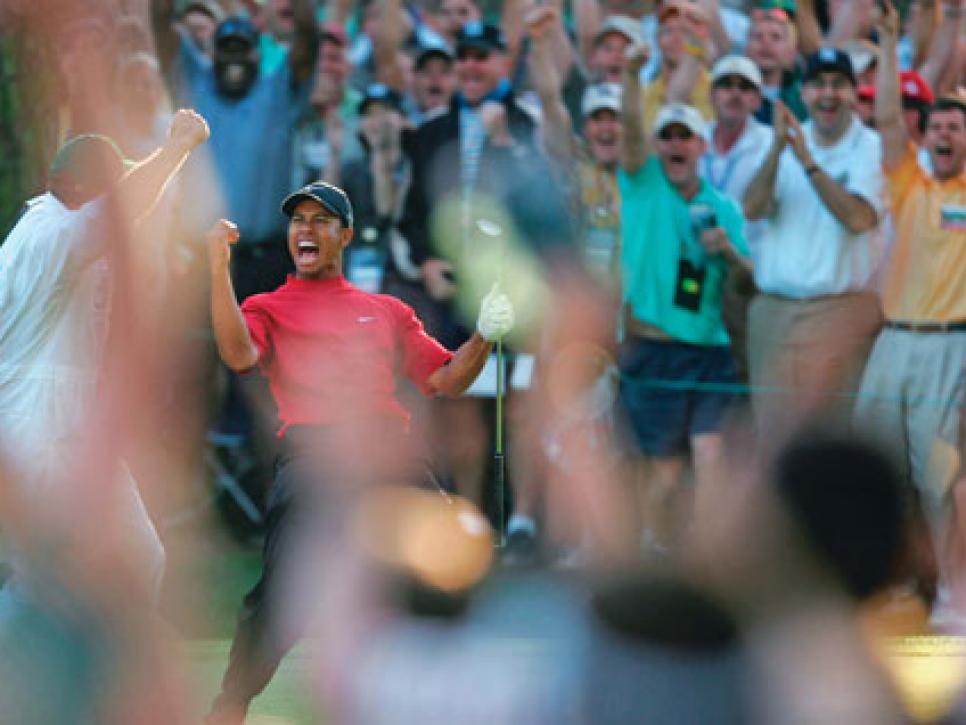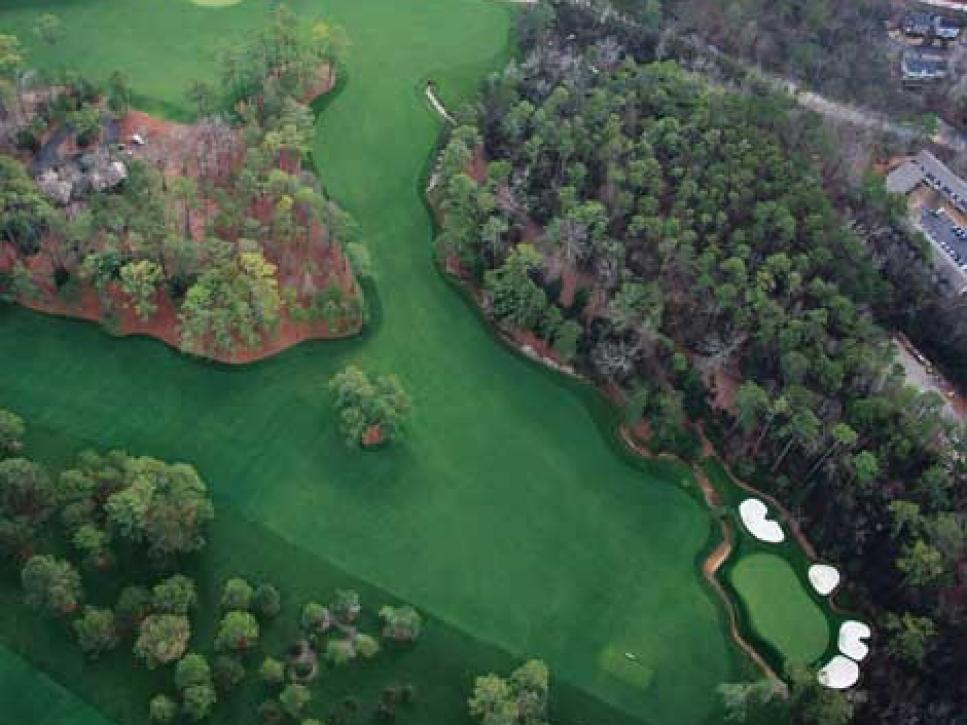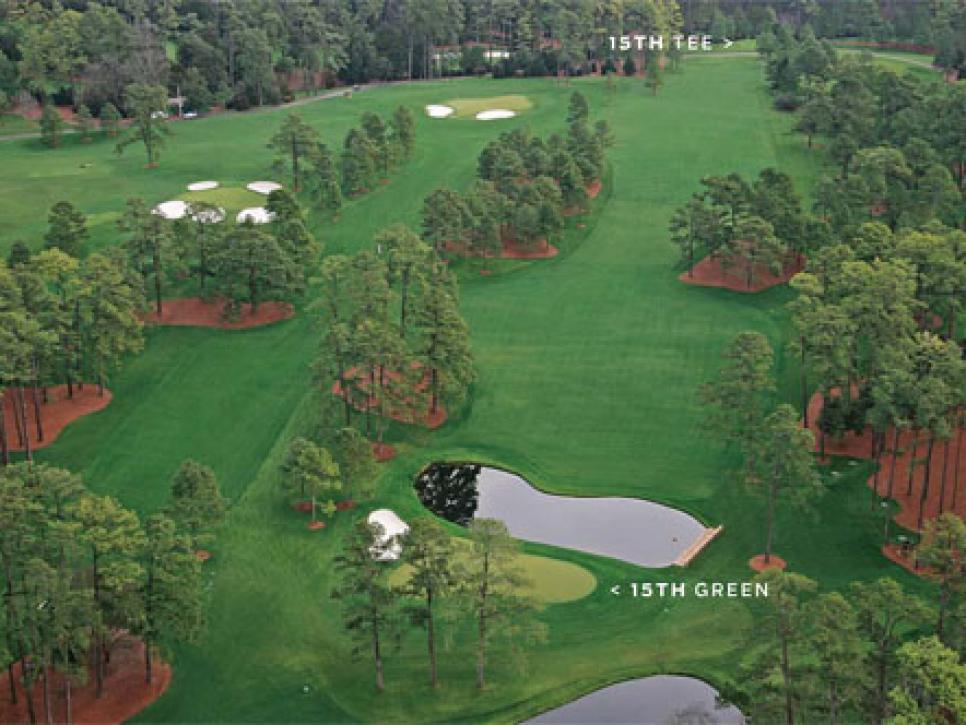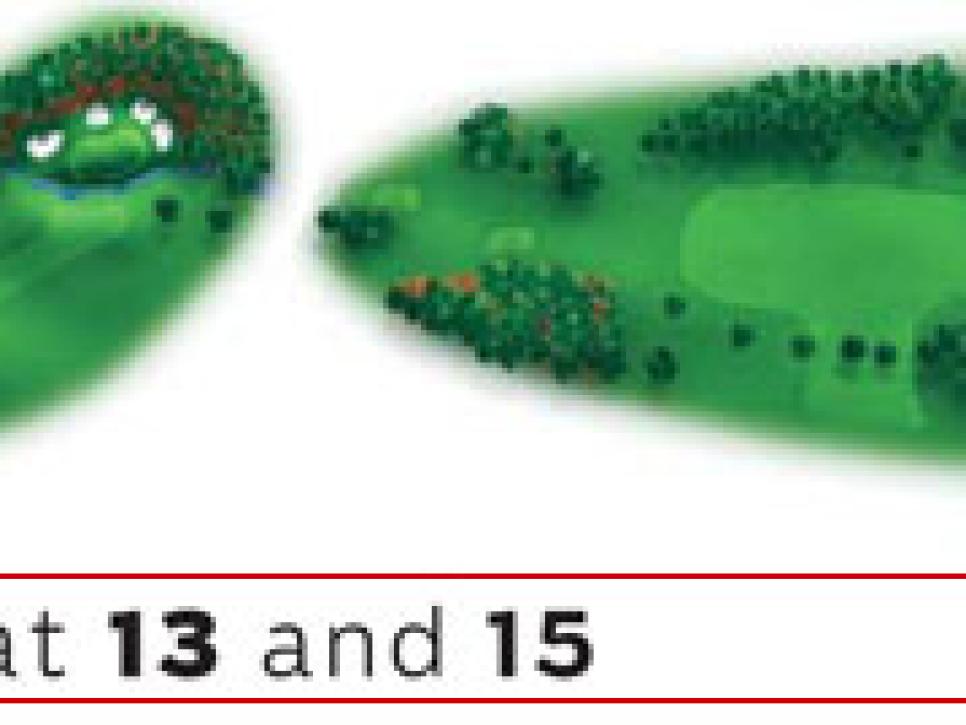Adjusting the Volume

We remember Tiger Woods' chip-in at the 16th hole and playoff birdie in 2005 more than his closing bogeys in regulation.
There are many who believe Augusta National--and, by extension, the Masters--have been ruined by the radical course changes of the last seven years. I'm not one of them. The truth is, whatever excesses have been perpetrated could be largely alleviated by subtly altering just two holes.
The redesigns under the direction of former chairman Hootie Johnson were bold and in principle a necessary attempt for a major championship to deal with the way the game is being played at the highest level. Johnson was right, beginning in 2002, to push back hard against the wedge-fest that had broken out on too many par 4s on the course that was 6,985 yards. That's not to mention all the middle- and even short-iron second shots that were being hit to the back-nine par 5s. When his last change before the 2006 tournament lengthened the course to 7,445 yards, it was for the not-unreasonable goal of having players return to hitting the same approach clubs that Bobby Jones intended.
There's irony in how the determination to go back to the future compromised some of the design principles of Jones and Alister Mackenzie. Augusta became not only longer but narrower because of the second cut of rough and pockets of newly planted trees (a reaction to straighter-hitting drivers and balls that curve less). The loss of fairway width has largely meant the end of the multiple approach angles to the flagstick that purists loved. Of course, there's a good argument that those angles became irrelevant when so many holes became a drive and a wedge, especially with so little penalty for wayward drives.
But the bigger effect is that to most Masters competitors, what was a thrilling roller-coaster ride has turned into a grim slog that begins on the climb toward the first green and ends with an even steeper ascent at the 18th.
Johnson was never known for his subtlety. If Augusta National were a museum piece--like another Mackenzie masterpiece, Cypress Point--the redesigns would have constituted a desecration. But Augusta's place has long been as a movable marker for the state of the elite game, an early adapter to evolutionary change. Furthermore, the Masters is a major championship, and if not the ultimate examination, it should at least be rigorous. Fun or no fun, it should demand the best of the best players.
The changes have done that, which is why I'm not put off when a short-hitting, supposedly off-brand player has won the Masters on the revamped course. Mike Weir maxed out his abilities in 2003, and so did Zach Johnson in 2007 and Trevor Immelman in 2008. When surprise champions emerged like Herman Keiser in 1946, Art Wall in 1959, Tommy Aaron in 1973 and Larry Mize in 1987, it did not repudiate the course or the setup. A top professional having a career week, particularly with the putter, is tough to beat on any course. Those who were bitter because Palmer or Nicklaus or Norman or Woods didn't win at Augusta and lost a chance at the Grand Slam that year could save themselves a lot of aggravation by remembering that.
BIG NAMES DISPLAYING BIG GAMES
That said, big names with big games traditionally win and contend at the Masters more than any other major, and that has been no accident. Augusta's most valued distinction remains the way it calls for "talent shots"--the big drive on a bold line, the high and soft-landing long iron, the dramatically shaped recovery, the perfectly pinched pitch, the imaginative chip. They are shots that display the highest skill and athleticism, and they have the smallest margin for error. Such shots take daring, which provides the adrenaline and theater that has made the Masters the best tournament on earth to play and to watch.
Even with the redesigns, it remains so, although the outcry would make you think those days are gone forever. Too many critics have fallen prey to nostalgia and legend, and they overestimate the level of excitement and noise that can reasonably be expected, especially when the last two years of Immelman and Johnson have been judged dramatic duds.
But a little perspective: For all the close finishes and big stroke swings and electric eagles and star-laden leader boards, the past is full of runaways and relatively dull Sundays. Claude Harmon was never threatened on Sunday in his five-stroke victory in 1948. Neither was Cary Middlecoff when he won by seven in 1955, and Raymond Floyd won by eight in 1976. The fact is, even at Augusta, the convergence of big-name contenders, memorable shots and tight finishes requires some luck.
Favorable weather is probably the most important factor. But also crucial is the course setup. The club has proved masterful in the way it can influence--by regulating flagstick positions and green firmness--the probability of excitement without compromising challenge. The players have appreciated this skill, regularly calling the tournament the best run in the world. It's why they've been more hesitant to publicly criticize the course setup than they are at others majors. "They've usually had someone who really knows the game to make the calls," says Tim Herron. "And for the most part, they've been good calls."
LESS EXCITING, LESS INTERESTING?
But since Hootie's changes, the players have become more outspoken about what they miss. And that is an arena that let them play with more art than anywhere else, with the freedom that comes from knowing that the course provided chances to make up for mistakes. It's easy to forget that the players love Augusta National like they love golf, and they know its charms more intimately than anyone else. And after seven years, they have reached the collective verdict that the Masters has become less exciting and perhaps less interesting.
"There are really no roars out there anymore," four-time winner Tiger Woods said after his first-round 72 last year, when he finished second to Immelman. "It's hard to make eagles and the big birdies. The golf course is playing so much more difficult now."
"There's not as much excitement," said Davis Love III. "There's a bunch of people putting for par. It's a little like the U.S. Open--you're playing defense a lot."
Three-time winner Nick Faldo best explained how the course was negating its best self. "If you don't have an opportunity to reward yourself, it switches off the best players," said Faldo, who says he stopped playing the tournament in 2006 because the re-design was too difficult. "They've got the flair and the skills to go for it, but going for it is suicide. Augusta was always the one where you can shoot your 65. Bottom line is, you've got to reward the guys... You've got to be given the opportunity to hit career shots."

SMALL CHANGES WITH BIG IMPLICATIONS
As always, the green jackets have stayed quiet, but clearly they listened. And, in their mandarin way, in the third year of the chairmanship of Billy Payne, they have acted. For the first time in 28 years, the course will play shorter than it did the year before. OK, so it's officially only 10 yards off the max, with the possibility of two other holes each playing about 10 yards shorter. But it's the right direction.
The shortening is being handled delicately, to avoid looking like a renunciation of Hootie's legacy. Probably more is in store. The changes are small, but on the thin edge of major-championship golf-course setups, a little can be a lot.
The first hole's gold marker--the approximate middle point of the teeing area--has been moved up 10 yards, ostensibly to allow more spectator flow. But at 455 yards uphill, there's little doubt that the first had become too difficult, especially into the wind. The fairway bunker that was enlarged for 2002 to keep long hitters from flying it, became--with the 20 yards that the hole gained in 2006--barely reachable for most players. Drives that died in the hill required a near-blind second shot with a medium to long iron to a very exacting target.
The 10 yards that have been added to the front of the tee on the par-4 seventh were sorely needed. The hole was the redesign's worst effort in terms of strategy and aesthetics. Lengthened by 85 yards since 2001, to 450 yards, it was also counter-intuitively tightened with more trees. Even after a good drive, the super-shallow green--which was built in the '30s to receive an exacting short iron or wedge--is unreasonably small for a middle-iron approach. As Woods has said, "I don't have that shot." What used to be a tricky and tantalizing risk-reward has become a hard par where the mandated conservative play is a competitive buzz kill.

"The whole thought process of playing the golf course used to be, get through the first six holes around par, and you can birdie 7, 8 and 9 ... and you have a great round," Phil Mickelson said last year. "It changes when you can be aggressive--and the whole complexion and the mind-set of how to play the first six or seven holes."
Mickelson's comment reflects the close attention paid by the players to issues like the course's ebb and flow, as well as their collective wish that, henceforth, less is more. No contemporary player is saying the club should go back to the course the way it was before the redesign--as tough as the par 4s are, Immelman played them in a record 10 under par last year--but the desire is to err on the side of tradition.
This should be especially true on the most important holes at Augusta, the iconic back-nine par 5s, the 13th and the 15th. A lot of the redesign's downsides--chiefly the askew risk-reward equation--would be alleviated by making them as accessible in two shots as they used to be. Both holes bring game-changing eagles into play. But the vacuum-like quality of the water hazards gives double bogey an equal chance. These two holes have made for the biggest Sunday stroke swings in major-championship golf.
The tournament's early history forged a go-for-it mentality. Until fairly recently, fairway-wood shots to the two par 5s were common. But of the many failures, perhaps only Billy Joe Patton in 1954 was ever considered foolhardy for pulling out the lumber. In 1985, Curtis Strange was criticized more for his execution than his decision when he dunked a 4-wood from 208 yards into the creek on 13, losing his lead to Bernhard Langer before rinsing a 4-iron on the 15th. Chip Beck, not a long hitter, got second-guessed in 1993 for keeping his 3-wood in the bag from 236 yards, laying up when he trailed Langer by three. But today--from the same yardage, which modern equipment would cover with less club--Beck would escape the hot seat. Players much longer than Beck now commonly lay up on 13 and 15 from inside 220 yards. Things have changed.
For starters, the 13th and 15th were lengthened in the redesign--the 13th by 25 yards in 2002, to 510, and the 15th by 30 yards in 2006, to 530. Simple arithmetic dictates that just as Hootie Johnson stopped Tiger Woods from ever again hitting a wedge for his second to the 15th, he also put a lot of medium hitters just short of their "go" point.
But attempts to hit 13 and 15 are decreasing for reasons that are more nuanced than yardage. For one, the equipment advances that giveth also taketh away.
Most pros say that with titanium-face drivers it's harder to hit a draw, the ideal shot shape for the tee shot on the dogleg-left 13th. Many players drop down to a 3-wood when they need a draw, and this used to be a common play on 13. But after the lengthening, a 3-wood leaves most players too far back to go for the green in two. Selecting the driver is also problematic because pushed tee shots commonly end up in a more wooded area than in the past. From there, the openings are fewer and the yardage is greater, which usually adds up to players laying up.

Even with a clear shot, other equipment advances can hinder going for the par 5s in two. The modern multilayer ball is hotter and spins less than balata, making it harder to stop on a long shot, especially approaches to the exacting targets the 13th and 15th greens have become. Their increasing firmness and sharper edges and faster slopes make it that much easier for a ball to run off into water. Because the embankment behind the 15th green has been groomed to be slicker than ever, a hot second shot runs the risk of trickling into the pond on the 16th hole.
Top players are getting so good with short pitches, percentages in most cases dictate that the smart play is a lay up that offers a decent chance of birdie while essentially taking bogey or worse out of play. There's also the psychological effect of a more difficult course overall. Augusta once allowed players to counterbalance the inevitable gambling miscues with definite birdie opportunities, but the redesigned course sends the opposite signal: The big number is a killer. "Where are you going to make up for it?" asks Arron Oberholser.
It makes sense that Weir and the other two shortish-hitting, low-ball-flight Masters champions since the redesign have relied on their excellent wedge skills to play 13 and 15. Zach Johnson won without ever going for a par 5 in two. Johnson, who nevertheless played the par 5s in 11 under par, laid up from 200 yards on the 13th on Sunday, saying that he had made a decision not to go for it unless he had a 4-iron or less. Last year, Immelman also laid up on 13 and 15 every day. "Too much to lose, too little to gain," he explained.
Billy Casper's strategy was considered aberrant when he used the lay up to win in 1970, but today it's easy to see why it's being adopted by all but the longest hitters. "I don't know if lay up/lay up isn't the best play on 13 and 15," says Brad Faxon.
The problem is that it's boring golf to watch. It's a procession of almost laughably mundane short-iron lay ups to what essentially becomes two 100-yard par 3s, giving the Masters another wedge-fest. The 13th, in particular, used to be considered the best tournament hole in the world, but that reputation is being diminished.
It also contributes to boring golf to play. Without a payoff looming on 13 and 15, players, to use Faldo's term, get "switched off" to creative, aggressive shotmaking and go into a sort of play-for-par U.S. Open mode that has hurt the Masters.
HOW TO RESTORE THE EXCITEMENT
So here's a simple stimulus package: Make the 13th and 15th worth going for in two again.
Augusta National has all the options. The club can move up some tees, soften greens, set less-dangerous hole locations, cut the fairway grass in the direction of the green instead of toward the tee, flatten some speed slot-killing fairway humps, trim some overhanging branches and take out a tree or six, grow the grass around the water hazards just a hair longer--or any combination of the above. The goal, as Jim Furyk succinctly states, should be to "put the gamble back in."
A first step has been taken, with the tee on 15 being moved forward about eight yards. Something similar should happen on 13. The landing area on 13 since the hole was lengthened is much more sidehill than the old one. The awkwardness of the lie, versus the more level former landing area, is a big inhibitor to players going for the green. Length isn't the issue as much as loss of control.
The club already has proof that a softening of the par 5s will work. In 2007, the second year the course played at its longest, 7,445 yards, the first three rounds were bedeviled by cold, wind and dried-out greens. Through 54 holes, only eight eagles had been scored. The night before the final round, the greens were watered, tees were moved up and the pins, particularly on the par 5s, were made accessible. On Sunday, in less wind, the field made 10 eagles. As Woods said, "They gave us a chance to go out there and score."
Even if the club does its part, it will still be up to the players to buy in. Habits formed since the punishing redesign caused a collective reprogramming of the Masters mind-set, but pro golfers make their living figuring out how to take what a golf course gives. An Augusta National with slightly more generous back-nine par 5s will spawn greedier--and more energized--players.
Raising the excitement level will be Anthony Kim and Camilo Villegas, who for the first time come to the Masters as legitimate winners and stars. Both possess powerful, hyper-aggressive games that, if switched on, can dominate par 5s. If they play well, or especially if one of them wins, their example could help swing the balance toward taking more risks, which would be a good thing.
However, the first move toward more excitement has to come from the men in green. Ultimately the key to the Masters getting its mojo back lies with getting back to getting it right.

The par 5s on the back nine -- the 510-yard 13th (top left) and 530-yard 15th (right) have been prime sources of drama during the Masters. Selected highlights:
1935: Gene Sarazen holes a 4-wood shot from 235 yards for a double eagle at the 15th, forcing a 36-hole playoff he wins by five strokes over Craig Wood.
1937: Byron Nelson eagles the 13th and wins by two over Ralph Guldahl, who makes a bogey at the 13th.
1954: Amateur Billy Joe Patton leads in the final round but makes a 7 at the 13th and a 6 at the 15th, finishing one shot out of a playoff that Sam Snead wins over Ben Hogan.
1958: Arnold Palmer eagles the 13th on Sunday -- a controversial ruling later in the round upholds his par at the par-3 12th hole -- and he wins by a stroke.
1975: Winner Jack Nicklaus calls the 1-iron he hit over the flag to the 15th a favorite shot, even though he missed the eagle putt.
1976: Winner Raymond Floyd's 5-wood sits behind glass in the Augusta National clubhouse because of his success with it on the par 5s that year.
1985: Curtis Strange hits water at 13 and 15, opening the way for Bernhard Langer.
1986: Nicklaus eagles the 15th, and Seve Ballesteros bogeys it after hearing a roar from Nicklaus' gallery at the 16th hole; Nicklaus wins his sixth Masters.
1993: Chip Beck lays up at the 15th and makes a par; Langer eagles 13 and birdies 15 to win by four.
1994: Jose Maria Olazabal's eagle at the 15th is the key moment in a two-stroke win.
1996: Nick Faldo's birdie at the 13th keeps the pressure on Greg Norman, whose chance at winning essentially ends when he misses chipping in for an eagle at the 15th.
1997: Tiger Woods plays 13 and 15 in eight under par and wins by 12.
1998: Fred Couples doubles the 13th and eagles the 15th on Sunday but loses by a stroke to Mark O'Meara.
2007: Zach Johnson never goes for a par 5 in two but is 11 under par on them for the week, including five birdies on 13 and 15.

